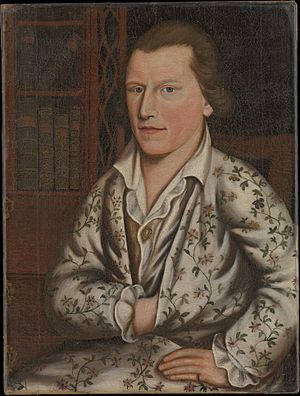Prince Demah facts for kids
Quick facts for kids
Prince Demah
|
|
|---|---|
| Born | c. 1745 |
| Died | 1778 |
| Nationality | American |
| Education | Robert Edge Pine |
| Known for | painting |
|
Notable work
|
Portrait of William Duguid, Portrait of Henry Barnes, Portrait of Christian Barnes |

Prince Demah (born around 1745 and died in March 1778) was an American painter. He was of African ancestry and lived in Boston in the late 1700s. Demah was once an enslaved person. The Metropolitan Museum of Art says he is the only known enslaved artist from colonial America whose paintings are still around today.
Early Life and Artistic Start
Prince Demah's mother was an enslaved woman named Daphney. Both Demah and his mother were baptized at Trinity Church in Boston in 1745.
In November 1769, Henry Barnes bought Demah. Barnes said he bought Demah to help him develop his "genius in painting." In October 1770, Barnes took Demah with him on a trip to London, England. The next year, Barnes wrote that Demah was taking lessons from "Mr. Pine." This was likely Robert Edge Pine, a British portrait painter. Pine was working in London at the time and later moved to Philadelphia. He took Demah on as a student because of his natural talent.
Known Paintings
Today, we know of three paintings by Prince Demah. One is a portrait of William Duguid. Duguid was a Scottish textile merchant living in Boston. This painting is now in the Metropolitan Museum of Art in New York City. Demah signed this portrait "Prince Demah Barnes" and dated it 1773.
The other two paintings are portraits of his owners, Henry and Christian Barnes. The Barnes family lived in Marlborough, Massachusetts. These portraits were given to the Hingham Historical Society. Even though they are not signed, experts believe Demah painted them.
Becoming Free and Later Life
The Barnes family were Loyalists. This meant they supported the British during the American Revolution. After some scary events, like Henry Barnes's horse being covered in tar and feathers, they left for England in 1775. Prince Demah stayed in Boston.
In April 1777, when the American Revolutionary War began, Demah joined the Massachusetts militia. He joined as a free man. The records show he called himself "Prince Demah," leaving out his former owner's name. This showed he was truly free.
Demah became sick and died the next year. He likely had smallpox. On March 11, 1778, he wrote his will. He signed it as "Prince Demah of Boston...a limner" and a "free Negro." A limner was an old term for a painter or artist. Demah left everything he owned to his "Loving Mother Daphne Demah." He was buried a week later at Trinity Church in Boston.

